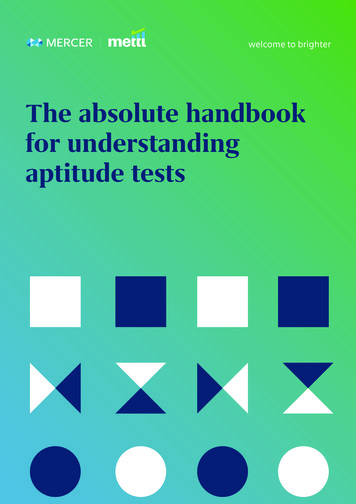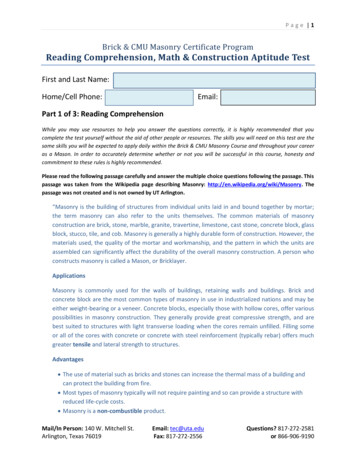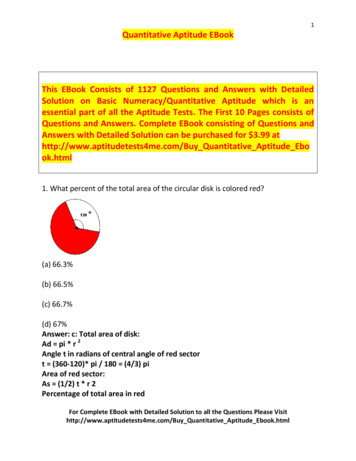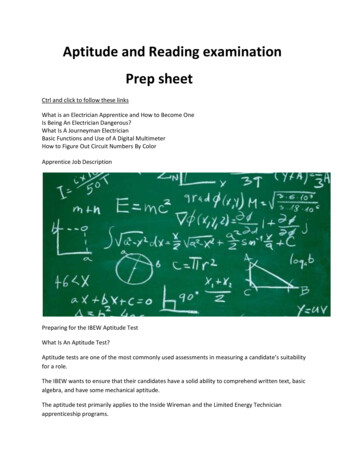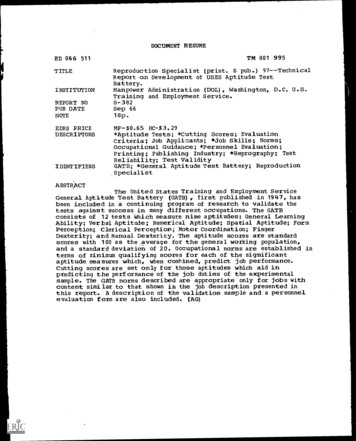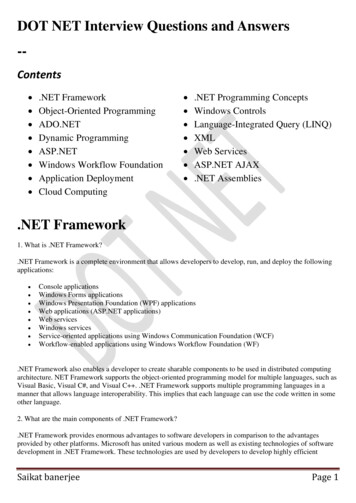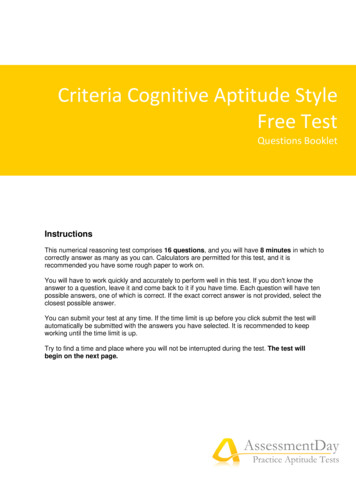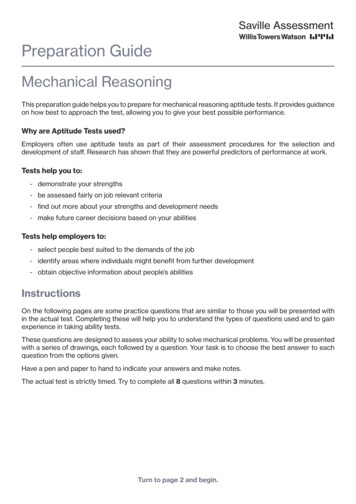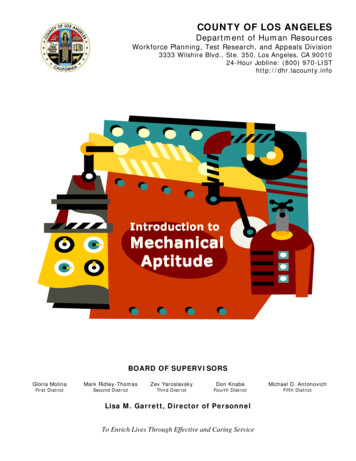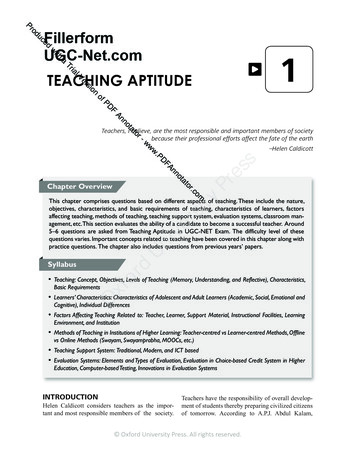
Transcription
educodPrithwa1iaTrnioserlVTEACHING APTITUDEFPDoftanoAnr-toTeachers, I believe, are the most responsible and important members of societybecause their professional efforts affect the fate of the earthwnnFADress.Pww–Helen Caldicottom.coryPatotChapter OverviewSyllabusordUniversitThis chapter comprises questions based on different aspects of teaching. These include the nature,objectives, characteristics, and basic requirements of teaching, characteristics of learners, factorsaffecting teaching, methods of teaching, teaching support system, evaluation systems, classroom management, etc.This section evaluates the ability of a candidate to become a successful teacher. Around5–6 questions are asked from Teaching Aptitude in UGC-NET Exam. The difficulty level of thesequestions varies. Important concepts related to teaching have been covered in this chapter along withpractice questions. The chapter also includes questions from previous years’ papers. Teaching: Concept, Objectives, Levels of Teaching (Memory, Understanding, and Reflective), Characteristics,xfBasic RequirementsO Learners’ Characteristics: Characteristics of Adolescent and Adult Learners (Academic, Social, Emotional andCognitive), Individual Differences Factors Affecting Teaching Related to: Teacher, Learner, Support Material, Instructional Facilities, LearningEnvironment, and Institution Methods of Teaching in Institutions of Higher Learning: Teacher-centred vs Learner-centred Methods, Offlinevs Online Methods (Swayam, Swayamprabha, MOOCs, etc.) Teaching Support System: Traditional, Modern, and ICT based Evaluation Systems: Elements and Types of Evaluation, Evaluation in Choice-based Credit System in HigherEducation, Computer-based Testing, Innovations in Evaluation SystemsINTRODUCTIONHelen Caldicott considers teachers as the important and most responsible members of the society.Teachers have the responsibility of overall development of students thereby preparing civilized citizensof tomorrow. According to A.P.J. Abdul Kalam, Oxford University Press. All rights reserved.
1.2UGC-NET Paper-I‘Teaching is a noble profession that shapes the character, calibre, and future of an individual. If peopleremember me as a good teacher, that will be the biggest honour to me’.The meaning of ‘teaching’ is to instruct someoneor impart knowledge regarding a subject or a skill.It is the process of flow of ideas, instructions, andknowledge from one mature person (teacher) to otherless mature persons (students). Teaching has beendefined by various experts in the following ways:Sustainable development goalsAim: To ensure inclusive and equitable quality education and promote lifelong learning opportunitiesfor all by 2030.OBJECTIVES OF TEACHINGThe objectives of teaching are given below: To provide knowledge and skills to learners sothat they can cope with the fast-changing world To mould and shape learners To nurture students during all stages of learning To inculcate values, morals, punctuality, anddiscipline in students To develop a sense of solidarity, brotherhood,communal unity, teamwork, leadership, etc., inlearners with the use of classroom activities To prepare students to be better citizens oftomorrowressTeaching is defined as an interactive process primarily involving classroom talk which takes placebetween teacher and pupil and occurs during certaindefinable activity.–Edmund AmidonersitTeaching is an intimate contact between a moremature personality and a less mature one which isdesigned to further the education of the latter.–MorrisonyPTeaching process is designed and performed to produce change in student behaviour.–ClarkeIn other words, the main objective of teaching isall-round development of students.UnivordTeaching is concerned with the activities which areconcerned with the guidance or direction of learningof others.–RyanxfTeaching is the stimulation, guidance, direction, andencouragement of learning.–BurtanOTeaching needs three qualities, Knowledge,Communication Skills, and Aptitude.When you think about ‘teaching’, there will bean image in your mind of an interaction between ateacher and a group of students in a classroom set-up.This is ‘formal teaching’. But there can be teachingeven outside the classroom as well. This is ‘informal teaching’, where one learns from family, friends,society, etc. So, teaching can be formal or informal.Teaching leads to skill development which improvesthe prosperity of the nation as educated and skilledworkforce will earn better. The meaning of ‘aptitude’is the ability to do something. ‘Teaching Aptitude’means the tendency to teach. Questions based onTeaching Aptitude relate to different aspects ofteaching and test the ability of a candidate to teach.LEVELS OF TEACHINGMemory Level The main proponent of Memory Level of teaching is Herbart. This is the initial level of teaching and a prerequisite for Understanding and Reflective levelsof teaching. The different phases of memory include learning, retaining, recalling, and recognizing. At this level, the teacher focuses on memorization of facts and information by learners. Thereis no attention on understanding of information, procedures, and concepts. The habit of rote learning is developed at thisstage so that learners can retain and recall theinformation whenever required. Teachers occupy the primary position with theirauthoritarian and dominant role, while learnersoccupy the secondary position. At this level, teacher-centred and subjectcentred methods are used. Oxford University Press. All rights reserved.
Teaching Aptitude It is suitable especially for lower classes. Oral and written tests and essay-type questionsare used to evaluate the learning.playing democratic role occupy the secondaryposition. Techniques used are student-centred. It is useful especially for higher classes as students of lower classes might not possess therequisite skills. Tests with essay-type questions are used forevaluation at this level. Also, there is evaluation of attitude, beliefs, involvement in learning and development of critical and creativeskills.Understanding LevelressNATURE AND CHARACTERISTICSOF TEACHINGyPTeaching is a science Teaching is a science as itis a systematic, logically planned activity. The aimof teaching is to shape the behaviour of studentsin a desired manner and it is outlined before starting teaching. It involves the use of scientific strategies, practices, and techniques to enhance learning.Teachers experiment with different strategies to testtheir effectiveness among themselves and among students. Teachers also maintain a record of the score ofstudents in tests to keep track of their performance.Universit The main proponent of Understanding Level ofteaching is Morrison. This level is an extension of Memory level. Italso lays the foundation for Reflective level. The memory level of teaching focused onlyon rote memorization of concepts, while at theunderstanding level, emphasis is on mastery ofthe subject by developing understanding andinsights. At this level, learners get to know about themeaning of concepts, generalizations, principles, and theories along with their applications. Teachers and learners play an active role inthe development of intellectual behaviour inlearners. Techniques used are teacher-centred and subjectcentred. More comprehensive techniques like essay andobjective-type questions are used for evaluationat the understanding dinglevelLevels of teachingReflective Level The main proponent of Reflective Level ofteaching is Hunt. It is the highest level of teaching and makes useof knowledge and research skills of learners forsolving real-life problems. It involves the use of problem-centric approach. Classroom environment is open and independent at this level of teaching. It also leads to the development of creativeskills. Learners occupy the primary position and participate actively in learning, while teachersTeaching is an art Teaching is based on creativityof the teacher to use different methods and aids ofteaching. What suits one student, may not suit others; so teachers have to adjust the strategies, practices, and techniques to the requirements, levels, andpersonality of the students. There is flexibility inteaching. Teaching also depends upon the aptitude,ability, personality, and knowledge of the teacher.Thus, teaching is an art.Teaching is a craft A craft requires skills or aset of skills that have been acquired through experience. Teaching is also a craft as it requires someskills like communication skills, creative thinking,critical thinking, class management skills, presentation skills, and confidence. It should be noted thatthese skills are not inherent always, but these can belearned through experience, observation, or training. Successful career in teaching is an outcome ofknowledge, skills, and hard work.Teaching is a moral activity The purpose ofeducation is all-round development of students. Oxford University Press. All rights reserved.
UGC-NET Paper-ITeaching is dynamic The teacher’s activities areinfluenced by various qualities and incidents andchange accordingly. They are not executed in strictroutines and regimes. So, teaching is dynamic andflexible.A teacher is like a small ship sailing from the land ofignorant people to the land of knowledgeable people.–SocratesBASIC REQUIREMENTS OFTEACHING The basic requirements of teaching includeTeacher (the independent variable) and Students(the dependent variable). The teacher uses different methods, strategies,aids, and learning materials, which act as intervening variables. Teaching is a continuous process, so patience,motivation, determination, and focus are thereal forces which keep students on track. Teaching is a complex activity; so the teacherneeds to be devoted and determined for the better future of students. Students should also have an interest in thesubject, activities, learning materials, etc. Classroom activity facilitates learning andhelps students retain information for a longerperiod. There is need of continuous and comprehensive evaluation so as to assess the performanceof students and suggest remedial measures forimprovement. Discipline is an important requirement of teaching. In the absence of discipline in the class, theteacher will not be able to teach students, nomatter how qualified he/she is. Classroom environment should be such that itencourages effective communication and interaction. Knowledge of teaching methods, effects ofteaching, principles of teaching, knowledge ofsubject, knowledge of the nature of students,etc., are also required for effective teaching.ersitTeaching is a complex activity Teaching is a science, an art, as well as a craft. Due to these multiple aspects of the nature of teaching, it is a complexactivity for which diverse sets of skills and abilitiesare required. A teacher has to deal with students ofdifferent personalities at the same time. While planning the teaching activity, a lot of factors have to beconsidered like student’s prior knowledge, pace oflearning, interests, etc.Students are now encouraged to ask questions andtake part enthusiastically in classroom activities.Teaching should be a dialogue, instead of being amonologue.Other than the characteristics mentioned above,teaching is a rational and reflective process. It isgoal-oriented, the goal here is the all-round development of students. Teaching facilitates learning.ressTeachers should not just focus on the prescribedsyllabus while ignoring the moral developmentof students. Students are the citizens of tomorrow. Classroom plays an important role in shaping them into citizens with good moral character.Moral and ethical aspects should be integrated in thecurriculum.yP1.4ordUnivTeaching is diverse Diverse means ‘showing agreat deal of variety’. There is diversity in everyclassroom; so teachers have to use diverse sets ofstrategies, methods, and techniques depending uponthe students.OxfTeaching is continuous Teaching can be seenas a lifelong learning process. It is not completedin just one step; rather it is a continuous process.Learning is now considered to be continuously a partof the journey from ‘Cradle to Grave’. Robert E. Leeremarks ‘the education of a man is never completeduntil he dies’.Teaching can be formal or informal As seenalready, teaching can be formal, as the interactionbetween teacher and student in a classroom set-up.On the other hand, teaching can also take place outside the classroom, which is informal teaching.Teaching is interactive Teaching is a two-wayinteraction between the teacher and learners. Thereis flow of knowledge from both the sides. Teachersas well as students learn in this communication process. Earlier, teaching practices were more teachercentric, but now the focus has shifted to learners. Oxford University Press. All rights reserved.
Teaching AptitudePrinciple of revision It is human tendency to forget whatever we read even within a few days. So, toretain knowledge, revision is compulsory. Studentsshould revise at home what they have covered in theclass. Homework should also be planned in sucha way that it leads to revision of class work. Testsshould be planned from time to time so that studentsrevise the content continuously.ersitPrinciple of interest According to this principle,students must have interest in the class. A teachershould only teach if the students have interest. Incase, students lack interest, then the teacher shouldfirst develop curiosity in them for learning. It canbe done by telling them how they will be able touse the new information in real life or by givingquestions first and then telling the concept used toanswer them. The teacher should relate theoreticalknowledge with practical examples from real life.He can also improve or change the teaching methodif students lack interest. Teaching aids can also beused to capture the interest of students.Principle of division It is not possible for a teacherto teach a whole concept at once. The teacher shoulddivide the topic into smaller units which are interrelated, so that on completion of one unit, studentsshould be curious to learn the next unit. This makeslearning easy and interesting as they will be dealingwith only one unit at a time.ressPrinciple of activity The teacher should involvethe students in learning through some activity. Thiswill help in better retention and they will not forgetwhat they have learnt. If the teacher is not able toengage the students, then they will not focus on whatis being taught. Activities can be classified into physical activity and mental activity. Benjamin Franklinsaid, ‘Tell me and I forget. Teach me and I remember. Involve me and I learn’. So, learning takes placewhen students are involved in it. This principle isused in Montessori Method, Role Playing Method,Project Method, Kindergarten Method, etc.help in optimum use of resources for the fulfilment ofpredetermined goals of teaching within the time limit.Without planning, it is difficult to complete the syllabus within the specified time. Course plan, lesson plan,test schedules, assignments, etc., should be planned.yPPRINCIPLES OF TEACHING1.5ordUnivPrinciple of democratic dealing The teacher canplay a democratic or authoritarian role. If the teacher’sbehaviour is authoritarian, then students will get littleor no opportunity to participate in learning and theywill be passive listeners. This will also affect the confidence of students. But if the behaviour of the teacheris democratic, then students will actively participatein learning. Student-centric methods should be usedin such classrooms which will help in developing selfconfidence, self-esteem, and self-respect in students.OxfPrinciple of linking with life Theoretical knowledge should be integrated with examples from real life.By this, students will learn at a faster pace and theywill be able to retain the new information which theyhave gained.Principle of definite aim The aims of teachingmust be predetermined and clearly defined so that theteaching activities can be planned accordingly alongwith the selection of teaching method and aids. Theaim and objective of the course and lesson shouldalso be communicated to students at the beginning ofclass. This will help in developing curiosity in them.Principle of selection Material should be selectedin such a way that it helps in fulfilment of the aims ofteaching. The content should be updated from time totime with respect to the updates in the field. It shouldalso be adjusted according to the needs of the students.Principle of planning Teaching activities, methods,and aids should be planned in such a way that theyPrinciple of motivation Every student possessessome unique skill and this need to be appreciated.If a student is not much good in studies, he mightbe good in some other activities. The teacher shouldencourage the skills of students and motivate them topursue a career of their choice and encourage themto sharpen their skills for a better future. Studentsshould be motivated for participating actively inlearning for better results. Rewards, gifts, praise,etc., can be used for motivating students. Stories ofgreat personalities and their experiences can alsoarouse motivation in students.Principle of recreation Recreation can be usedfor tackling the fatigue of lengthy classes which usually end with bored and frustrated students. It willenhance creativity in class and engage the students. Oxford University Press. All rights reserved.
UGC-NET Paper-IPrinciple of remedial teaching The teachershould be able to identify and understand the problems, and suggest remedial measures for these problems.Principle of sympathy A teacher should be kind,caring, and sympathetic. This will help him in building cordial and trustworthy relation with students.This will also have an effect on the teaching.ersitPrinciple of creativity The teacher should encourage creativity and critical thinking in students.Teaching methods should be selected in such a waythat they help in enhancing the students’ creativityand critical thinking.2. It is easy for students to build new knowledgeif they are able to relate it to what they alreadyknow. So, teaching should flow from knownto unknown. Past experiences of the studentsshould be linked to new teaching.3. Similarly, the teacher can plan the lesson toflow from seen to unseen. Such an approachcan be used for better understanding of students.4. The teacher should explain the establishedfacts first and then move on to abstract facts.So, teaching should proceed from concrete toabstract facts.5. Specific facts should be discussed first, andthen these should be used to generalize, by following the approach from particular to general. Such an approach is inductive in nature.6. It might be difficult for students to understandthe whole topic at once. The teacher should present the whole topic by breaking it into smallerparts, so that they can grasp it easily. Theapproach used here is fromm whole to part.7. While planning the lecture, the teachershould keep in mind the psychological needsof students first and then go into the logicalarrangement of concepts. By addressing thepsychological needs first, the teacher will beable to engage the students. So, the lessonplanning should be from psychological tological.8. The teacher should first teach analysis and thensynthesis. According to the Oxford EnglishDictionary, ‘analysis’ means ‘the process ofseparating something into its constituent elements’ and ‘synthesis’ means ‘the combinationof components or elements to form a connectedwhole’. So, for better understanding and clarity, a problem should be divided into parts foranalysis and then the parts can be combined tosolve the whole problem by synthesizing.9. Empirical knowledge is based on experiencewhile rational knowledge is based on logic.Teaching can start with empirical knowledgeandd proceed to rational knowledge. Empiricalknowledge is specific and rational knowledgeis general.10. The teacher should always encourage self-studyamong students.ressPrinciple of individual differences No two students have the same ability, skill, and personality.So, the teacher should be able to recognize the individual difference in students and address their specific needs for effective teaching. Though studentshave individual differences, teaching should beplanned in such a way that all students have equalopportunities and no one is left behind.yP1.6ordUnivPrinciple of reinforcement Teachers can reinforce students verbally, by praising them, or bygiving gifts and rewards for good and responsible behaviour, correct answers, good grades, etc.This will encourage them to continue their hardwork and practice good habits.OxfPrinciple of training the senses Sensory organsplay an important role in learning. Different activities, methods, and aids involve the use of differentsensory organs such as the eyes and ears.DID YOU KNOW?World Teachers Day is celebrated every year on5th October.How to TeachA teacher should keep the following in mind whileteaching:1. Students understand simple things easily. So, ateacher should approach from simple to complex content. Explain simple concepts first, andthen the complex. Oxford University Press. All rights reserved.
Teaching AptitudeLEARNERS’ CHARACTERISTICSAcademiccharacteristicsSocial oremotionalcharacteristicsCognitivecharacteristics Include Learninggoals, priordemoknowledge,graphicinformaand education of thetional levellearnersof learners tus,culturalbackground,etc. Based on therelation of agroup or of anindividual withthe group Group structure, place ofthe individualwithin a group,sociability,self-image,mood, etc. Determinehow thelearnerperceives,remembers,thinks, solvesproblems, organizes, andrepresentsinformation inher/his brain Attentionspan, memory, mentalprocedures,and intellectual skillsressPersonalcharacteristicsyPThe teacher should plan the classroom activity onthe basis of the above-stated characteristics of thestudents.ersitThere has been a growing usage of the term‘Learner’ as a synonym for ‘Student’, similar to theuse of ‘Learning’ for ‘Teaching’. But there is somedifference between these terms. Learning can takeplace even without teaching, but teaching is unimaginable without some form of learning. Similarly, theterm ‘Learner’ is broader than ‘student’, as learnerscan learn even in the absence of the teacher, but ateacher is required for students. Learning can takeplace inside as well as outside the classroom, butteaching is only inside the classroom. Learning is alifelong pursuit, so the excitement and willingnessto find and learn should be nurtured throughout life.The characteristics of learners revolve around theirpersonality, attitude, confidence levels, prior knowledge, ability, etc.On the basis of nature, characteristics of adolescent and adult learners can be categorized as: personal, academic, social or emotional, and cognitive.1.7UnivCharacteristics of good learners6. They always find time for reading, analysing,and evaluating the information they have gathered.2. They know how to make use of their knowledge, that is, how it can be used to solve real-lifeproblems.7. They enjoy learning and don’t dishearten overthe hardships which arise in the journey of learning.ord1. Good learners are persistent. The process ofdevelopment for good learners is continuous andgradual.Oxf3. They share their knowledge with others and donot restrict it to just themselves. They know verywell that knowledge increases by sharing.4. They are free from negative emotions whichweaken the learning abilities such as anger, jealousy, greed, and so on.5. They are always curious to learn about something they do not know. They are always in searchof new knowledge.LEVELS OF LEARNINGBloom’s TaxonomyIn 1956, under the leadership of Dr. Benjamin Blooma new vision for teaching, now called Bloom’sTaxonomy, was developed which focused on understanding, analysing, and evaluating concepts, principles, and procedures.8. They have a lot of questions. They seek to learnnew things while finding answers to their questions. As said by Langer, ‘If we would have newknowledge, we must get a whole world of newquestions’. So, getting answers also leads toanother set of questions and the learning continues.9. They have the ability to associate new knowledge with what they know already. Their knowledge base is updated continuously.According to Bloom’s Taxonomy (also known asKSA), there are three domains of learning: Cognitive Domain – focuses on Knowledge Psychomotor Domain – focuses on Skills Affective Domain – focuses on Attitude Oxford University Press. All rights reserved.
UGC-NET Paper-IAffective domain This domain was proposedby Krathwohl. It is concerned with feelings andemotions, which can be arranged as (from simple to complex) Receiving, Responding, Valuing,Organization, andd Characterization.Reception Gain attention of students. Voice modulations, gestures, short introductory video, handouts, etc. can be used for this purpose.Expectancy Inform them about the objectives ofwhat they are about to learn so that their interest willbe developed.Retrieval Relate the new information with theirprior knowledge.Selective perception Present the new informationin an effective and easy-to-understand manner usingdifferent methods and aids depending on the needsand level of students.Semantic encoding Help students to learn andretain new information by use of examples, casestudies, storytelling, etc.ersitPsychomotor domain Also called kinestheticdomain, it relates to natural, autonomic responsesor reflexes. There are different models of psychomotor domain. Simpson had includedd Perception,Set, Guided Response, Mechanism, ComplexOvert Response (to know what will be the resultimmediately after performance), Adaptation, andOrigination. Dave used Imitation, Manipulation,Precision, Articulation, andd Naturalization. Harrowtalks about movements by using Reflex Movements,Fundamental Movements, Perceptual Abilities,Physical Abilities, Skilled Movements, andd NonDiscursive Communication.his book The Conditions of Learningg identified thefollowing mental conditions essential for effectivelearning:ressCognitive domain Cognitive domain comprisessix sub-categories, namely (arranged from simple tocomplex) Knowledge, Comprehension, Application,Analysis, Synthesis, and Evaluation. Knowledge,comprehension, and application involve low orderthinking skills and the other three, analysis, synthesis, and evaluation, involve high order thinkingskills.Cognitive domain was revised by Lorin Anderson and David Krathwohl in 2001. The new versioninvolves Remembering, Understanding, Applying,Analysing, Evaluating, andd Creating.yP1.8xfordUnivResponding At this stage, students can demonstrate what they have learnt through question–answer rounds, role playing, etc.OGagne’s Nine Levels of LearningIt is also known as Gagne’s Nine Conditions ofLearning, Gagne’s Nine Events of Instruction, orGagne’s Taxonomy of Learning. Robert Gagne inReinforcement Provide feedback to students onthe basis of their responses and reinforce importantpoints for their clearing doubts and helping in retaining new information.Retrievaltests.Assess their performance through someGeneralizations Students should apply what theyhave learnt to new situations and conditions, thenwith practice they will be able to generalize it.In general, the levels of learning can be simplified as shown in the below figure:TeachingAssimilating andimplementingReflectingListening,reading Oxford University Press. All rights reserved.
Teaching AptitudeIntelligence There is difference in intelligencelevel of different learners. It can affect their ability to grasp content. Some learners can understandquickly, while others may need to spend more time.It also affects their ability to remember, recall, andreinforce.Environment For effective learning, the learnershould be in a comfortable environment. Differentlearners can be comfortable in different types of environment. Some can learn better in groups or if thereare other learners around them, such as in a library,whereas some others may prefer learning individually.ersitAptitude This is the ability to do something. Thelearner’s aptitude affects his performance. In manyresearch studies, it has been found that higher levelof aptitude results in better performance in learningand retaining it. It is also related to critical thinkingof the learners.Attitude The attitude of the learner is also a verysignificant factor. A positive attitude will help inlearning effectively. The different aspects of attitudesuch as interest, open-mindedness, cheerfulness,prejudice, and affection help in shaping the personality of the learner.ressIn the case of learning, ‘one size fits all’ is not true.Not everyone can learn in the same manner. Forexample, while some students cannot study withoutloud music, others need a calm environment. Somelearners can be comfortable with online courses, butothers may prefer textbooks over online study material. Thus, there are differences among learners. Thesedifferences are discussed below:Learning style Every learner has a different learning style. Some need complete silence, while othersmay need music to concentrate. Some may learn better with discussions, while others may like to studyalone. Some may prefer e-books and other onlinematerials, whereas others may be more comfortablewith textbooks.yPINDIVIDUAL DIFFERENCES AMONGLEARNERS1.9UnivHealth The health of the learner influences hisability to learn, remember, and recall. A learnerwith poor health will not be able to concentrate. Theteacher should take extra care of a student with poorhealth; for example, a student with poor eyesight,can be seated in the first row in the classroom.The individual differenc
workforce will earn better. The meaning of ‘aptitude’ is the ability to do something. ‘Teaching Aptitude’ means the tendency to teach. Questions based on Teaching Aptitude relate to different aspects of teaching and test the ability of a candidate to teach. Sustainable development
